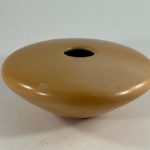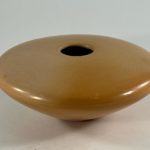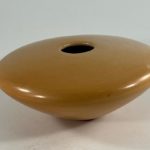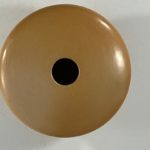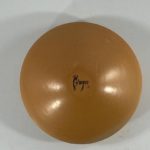This plainware jar is the perfect foil for jar 2020-20, the other recent addition to this collection by Jake Koopee. Whereas jar 2020-20 is packed with design leaving almost no surface on the pot without paint, jar 2022-02 obviously carries no paint (except for the signature) and derives its beauty from form and firing blush. Mark Tahbo seems to have developed the idea of making fine planware pottery (see below), but other potters, including Jake, were attracted to the idea and followed suit. Jar 2022-02 is the result.
Form:
From a 1-inch base, jar 2022-02 flairs sharply upward 2.625 inches to the jar’s waist, then curves gently 2.125 inches to a 1-inch mouth. The diameter of the jar is this almost 5 times larger than the base. That ratio, combined with the steep incline of the jar below the waist, makes the vessel seem to rise off a surface on which it is placed.
The top surface of the jar is gently domed, a tour de force since the wet coils of clay used to construct this surface tend to collapse inward because they are not supported from below. In order to minimize this danger, the top surface of the jar is unusually thin.
The polishing of the jar is exceptional, the striations of the polishing stone almost invisible. The blushing from the firing is almost uniform, only slightly darker on one edge of the underside.
Design:
The lack of design on jar 2022-02 is its defining characteristic.
Design analysis:
While the vessel is designed for maximum visual appeal, it also has a fine tactile presence. As I turn the jar in my hands, the rounded waist slips smoothly in my fingers, marking the dramatic sift in shape from the bottom to the top of the form. Held, turned, and fondled in the hands, it feels like a finely polished piece of ivory or a cool, smooth stone. For me this tactile experience is as moving as encountering the pot visually.
The process of making pottery at Hopi is very laborious. First clay needs to be dug, ground, purified, soaked and strained. Beeweed needs to be collected in the spring, boiled and reduced to a viscous syrup that then hardens on corn husks. Yucca leaves are gathered for making brushes; hardened beeweed is ground with a hemitite pestle to make black paint. Special yellow clay is located, dug and ground to make the yellow paint that fires red. Dried sheep dung is bought or cut out of old corrals. Then a pot is coiled, smoothed, sanded, polished and painted before being ready to fired at dawn on a windless day.
In the 1990’s Mark Tahbo was beginning to be recognized as an artist and he perfected the process of firing his pots outdoors so they would receive attractive blushing from the heat. Such blushing became a signature characteristic of his pottery (cf 1992-02, 1995-10). He realized that he could sell his well-fired pots without decorating them, if the form was close to perfect. These pots sold well without the need to paint them, which increased his productivity.
Jar 2022-02 is made in this tradition by another master potter at the height of his career, about to be cut short by his stupid, untimely, young death. This small perfect jar is a memorial to greatness lost.



